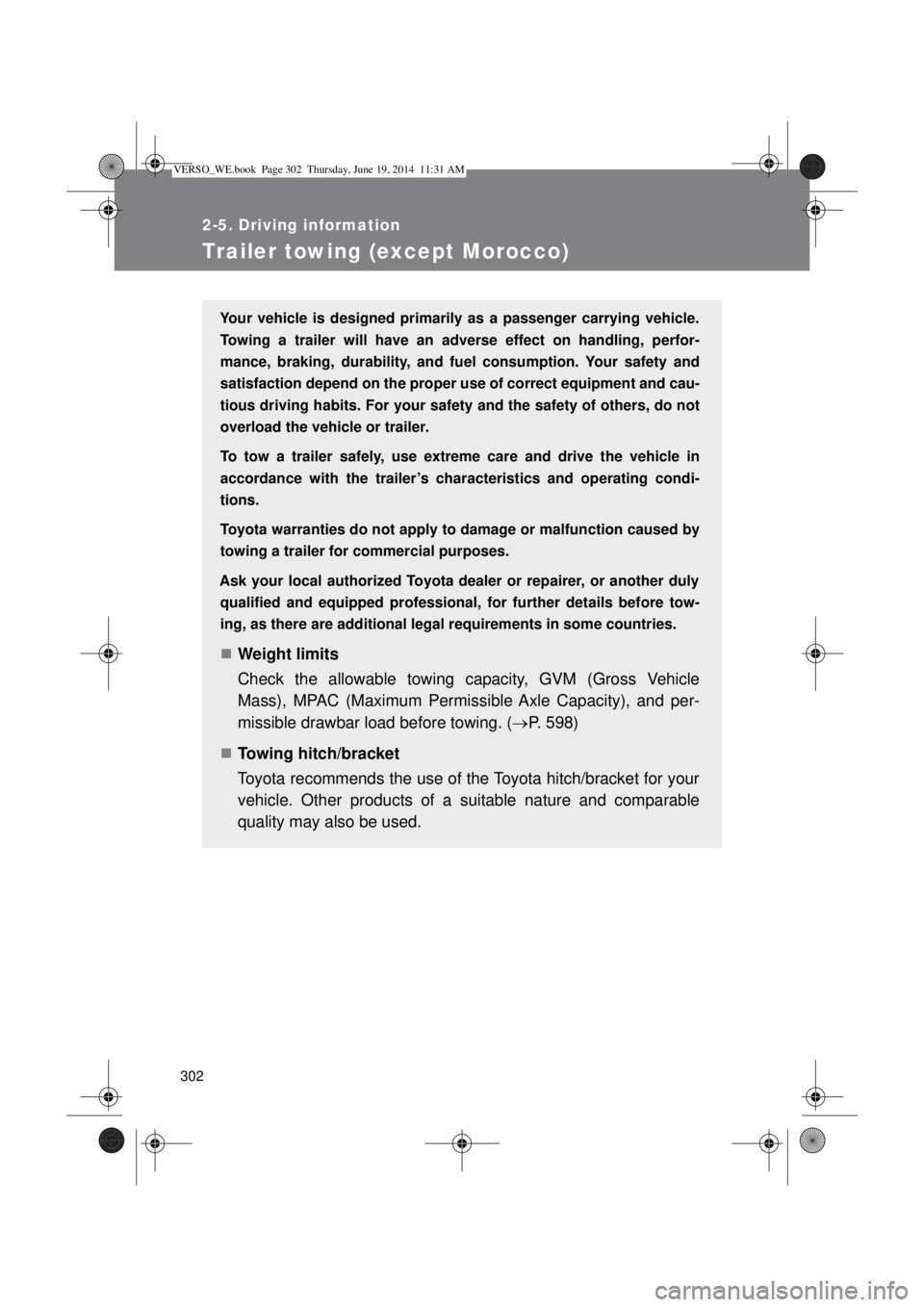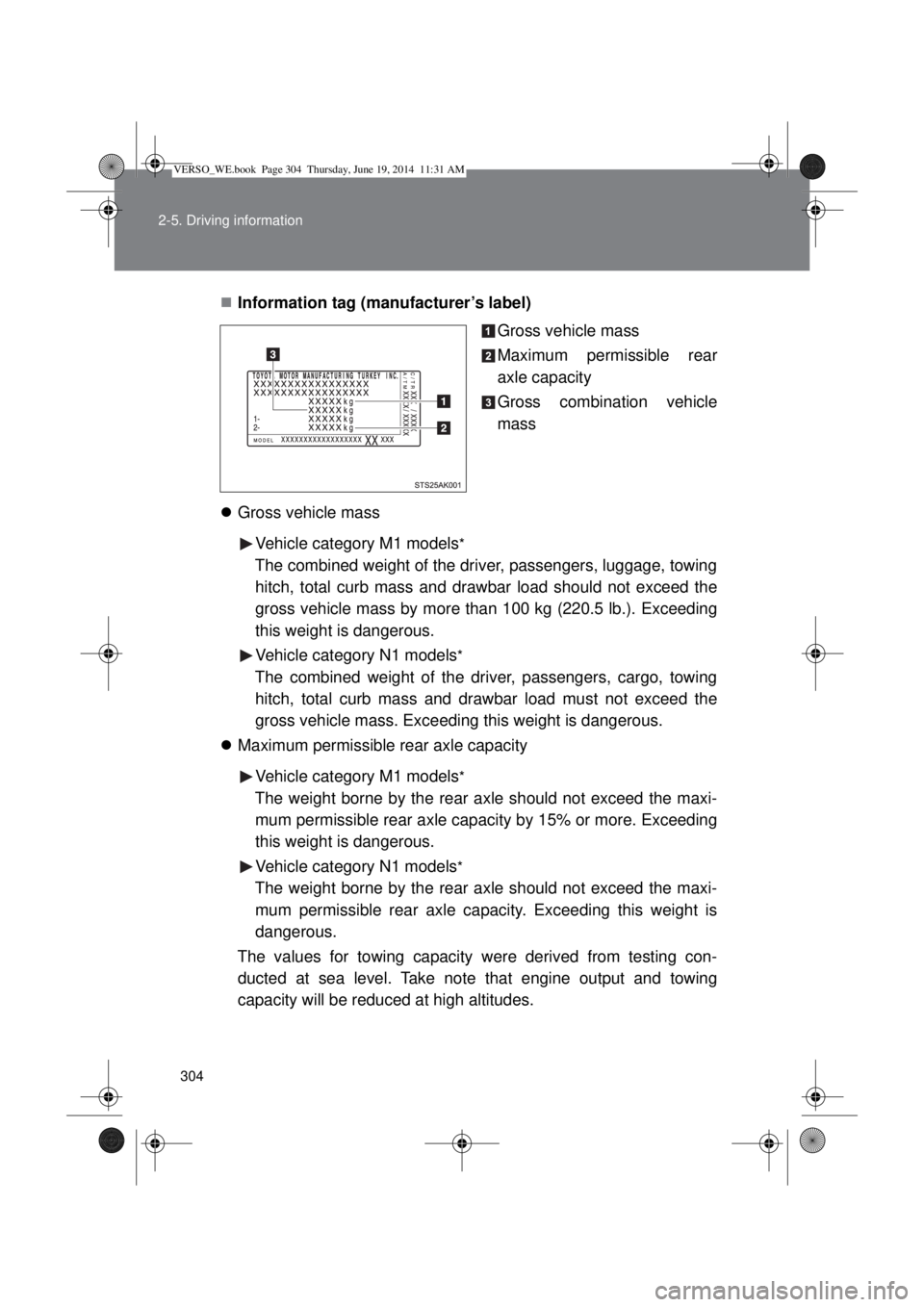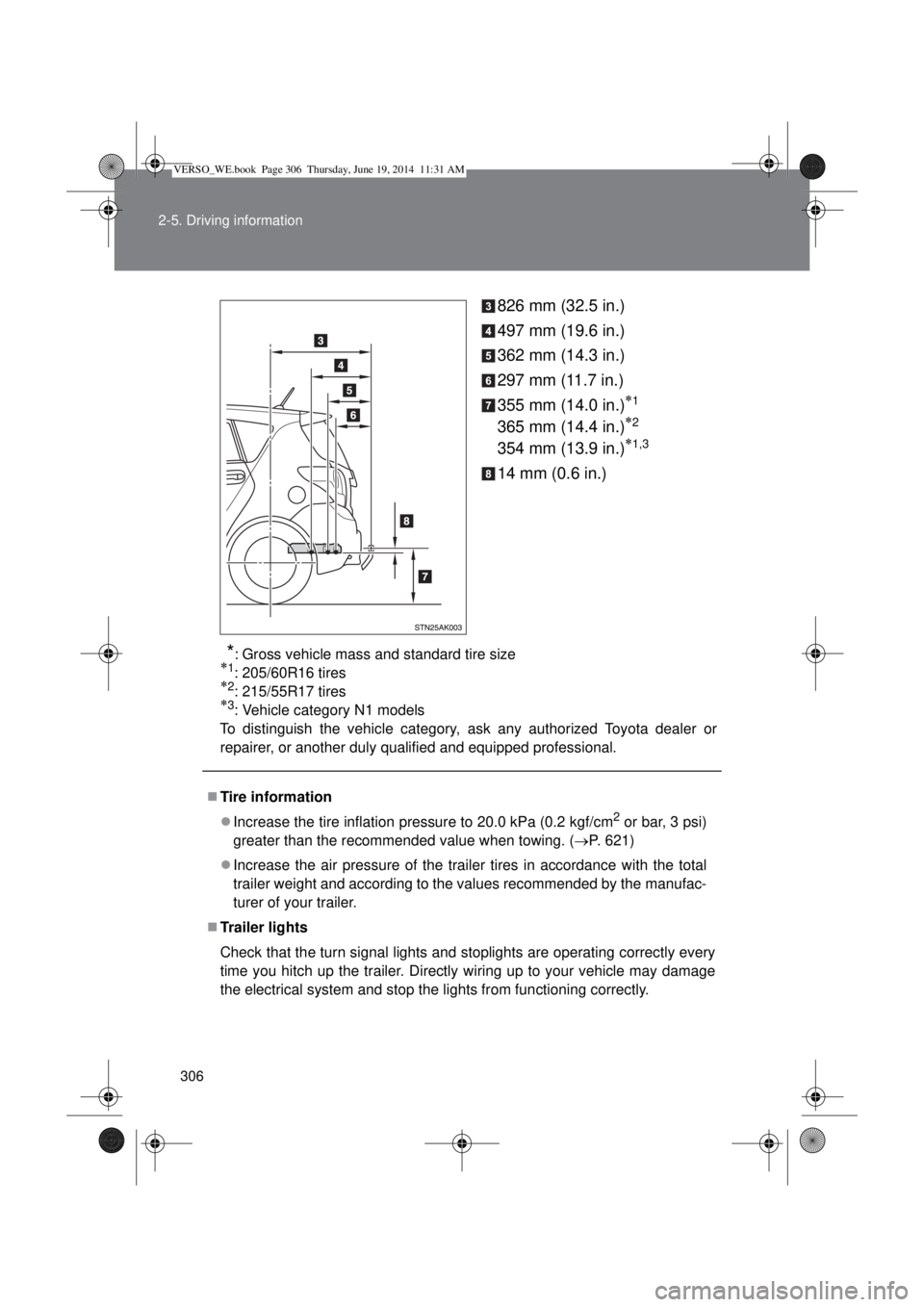Page 302 of 650

302
2-5. Driving information
Trailer towing (except Morocco)
Your vehicle is designed primarily as a passenger carrying vehicle.
Towing a trailer will have an adverse effect on handling, perfor-
mance, braking, durability, and fuel consumption. Your safety and
satisfaction depend on the proper use of correct equipment and cau-
tious driving habits. For your safety and the safety of others, do not
overload the vehicle or trailer.
To tow a trailer safely, use extreme care and drive the vehicle in
accordance with the trailer’s characteristics and operating condi-
tions.
Toyota warranties do not apply to damage or malfunction caused by
towing a trailer for commercial purposes.
Ask your local authorized Toyota dealer or repairer, or another duly
qualified and equipped professional, for further details before tow-
ing, as there are additional legal requirements in some countries.
Weight limits
Check the allowable towing capacity, GVM (Gross Vehicle
Mass), MPAC (Maximum Permissible Axle Capacity), and per-
missible drawbar load before towing. (P. 598)
Towing hitch/bracket
Toyota recommends the use of the Toyota hitch/bracket for your
vehicle. Other products of a suitable nature and comparable
quality may also be used.
VERSO_WE.book Page 302 Thursday, June 19, 2014 11:31 AM
Page 303 of 650
303 2-5. Driving information
2
When driving
Important points regarding trailer loads
Total trailer weight and permissible drawbar load
Total trailer weight
Weight of the trailer itself plus the
trailer load should be within the
maximum towing capacity.
Exceeding this weight is danger-
ous.
(P. 598)
When towing a trailer, use a fric-
tion coupler or friction stabilizer
(sway control device).
Permissible drawbar load
Allocate the trailer load so that
the drawbar load is greater than
25 kg (55.1 lb.) or 4% of the tow-
ing capacity. Do not let the draw-
bar load exceed the indicated
weight. (P. 598)
VERSO_WE.book Page 303 Thursday, June 19, 2014 11:31 AM
Page 304 of 650

304 2-5. Driving information
Information tag (manufacturer’s label)
Gross vehicle mass
Maximum permissible rear
axle capacity
Gross combination vehicle
mass
Gross vehicle mass
Vehicle category M1 models
*
The combined weight of the driver, passengers, luggage, towing
hitch, total curb mass and drawbar load should not exceed the
gross vehicle mass by more than 100 kg (220.5 lb.). Exceeding
this weight is dangerous.
Vehicle category N1 models
*
The combined weight of the driver, passengers, cargo, towing
hitch, total curb mass and drawbar load must not exceed the
gross vehicle mass. Exceeding this weight is dangerous.
Maximum permissible rear axle capacity
Vehicle category M1 models
*
The weight borne by the rear axle should not exceed the maxi-
mum permissible rear axle capacity by 15% or more. Exceeding
this weight is dangerous.
Vehicle category N1 models
*
The weight borne by the rear axle should not exceed the maxi-
mum permissible rear axle capacity. Exceeding this weight is
dangerous.
The values for towing capacity were derived from testing con-
ducted at sea level. Take note that engine output and towing
capacity will be reduced at high altitudes.
VERSO_WE.book Page 304 Thursday, June 19, 2014 11:31 AM
Page 306 of 650

306 2-5. Driving information
826 mm (32.5 in.)
497 mm (19.6 in.)
362 mm (14.3 in.)
297 mm (11.7 in.)
355 mm (14.0 in.)
1
365 mm (14.4 in.)2
354 mm (13.9 in.)1,3
14 mm (0.6 in.)
*: Gross vehicle mass and standard tire size1: 205/60R16 tires2: 215/55R17 tires3: Vehicle category N1 models
To distinguish the vehicle category, ask any authorized Toyota dealer or
repairer, or another duly qualified and equipped professional.
Tire information
Increase the tire inflation pressure to 20.0 kPa (0.2 kgf/cm
2 or bar, 3 psi)
greater than the recommended value when towing. (P. 621)
Increase the air pressure of the trailer tires in accordance with the total
trailer weight and according to the values recommended by the manufac-
turer of your trailer.
Trailer lights
Check that the turn signal lights and stoplights are operating correctly every
time you hitch up the trailer. Directly wiring up to your vehicle may damage
the electrical system and stop the lights from functioning correctly.
VERSO_WE.book Page 306 Thursday, June 19, 2014 11:31 AM
Page 506 of 650
506 5-1. Essential information
Installing towing eyelet
Remove the eyelet cover using a
flathead screwdriver.
To protect the bodywork, place a
rag between the screwdriver and
the vehicle body, as shown in the
illustration.
Insert the towing eyelet into the
hole and tighten partially by
hand.
Tighten down the towing eyelet
securely using a wheel nut
wrench
* or hard metal bar.
*: If a wheel nut wrench is not
equipped, a wheel nut wrench
can be purchased at any autho-
rized Toyota dealer or repairer, or
another duly qualified and
equipped professional.
Location of the emergency towing eyelet
P. 536, 552
VERSO_WE.book Page 506 Thursday, June 19, 2014 11:31 AM
Page 599 of 650
599 6-1. Specifications
6
Vehicle specifications
Drawbar load
Except 1AD-FTV
engine55 kg (121 lb.)
1AD-FTV engineGross combination vehicle
mass
*9 is 3760 kg
60 kg (132 lb.)
Gross combination vehicle
mass
*9 other than 3760 kg
55 kg (121 lb.)
Towing capacity
With brake
Except 1AD-FTV
engine
1AD-FTV engine1300 kg (2866 lb.)
Gross combination vehicle
mass
*9 is 3760 kg
1500 kg (3307 lb.)
Gross combination vehicle
mass
*9 other than 3760 kg
1300 kg (2866 lb.)
Without brake 450 kg (992 lb.)
Maximum permissible mass for towing
hitch/bracket
*320 kg (44 lb.)
VERSO_WE.book Page 599 Thursday, June 19, 2014 11:31 AM
Page 623 of 650
623 6-1. Specifications
6
Vehicle specifications
When towing a trailer
Add 20.0 kPa (0.2 kgf/cm
2 or bar, 3 psi) to the recommended tire inflation
pressure, and drive at speeds below 100 km/h (62 mph).
When installing a compact spare tire (vehicles with compact spare tire)
Do not tow if your vehicle has a compact spare tire installed.
VERSO_WE.book Page 623 Thursday, June 19, 2014 11:31 AM